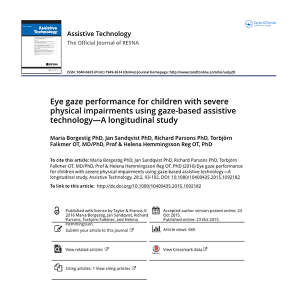
Gaze-based assistive technology (AT) offers the potential to give children suffering from severe physical impairments a number of new opportunities to participate in activities and better communicate with parents, teachers, and peers. In this white paper, a study focused on the changes in eye gaze performance over a specified period of time was conducted to determine if these efforts were effective and beneficial to those suffering from impairments.
According to the findings, the children in the study improved in timed tasks after just five months, and they became more accurate in their ability to select targets at the 15 to 20 month period.
The paper here highlights the methods used in the study to improve the participant’s eye gaze AT and how the study affected children with different physical impairments.
Key takeaways of this white paper include:
- Method and measurement used for determining eye-gaze AT throughout the study
- How different impairments resulted in different results and successes
The data collection process lasted for many months and during this period, virtually all children involved improved in some way regarding their eye gaze performance, leading to the conclusion that the methods used were effective and beneficial.
Originally published by tandfonline.com on 9/4/2015
Eye-gaze-technology-for-children-with-physical-impairments
Citations
Borgestig, M., Sandqvist, J., Parsons, R., Falkmer, T., & Hemmingsson, H. (2016). Eye gaze performance for children with severe physical impairments using gaze-based assistive technology—A longitudinal study. Assistive technology, 28(2), 93-102.


